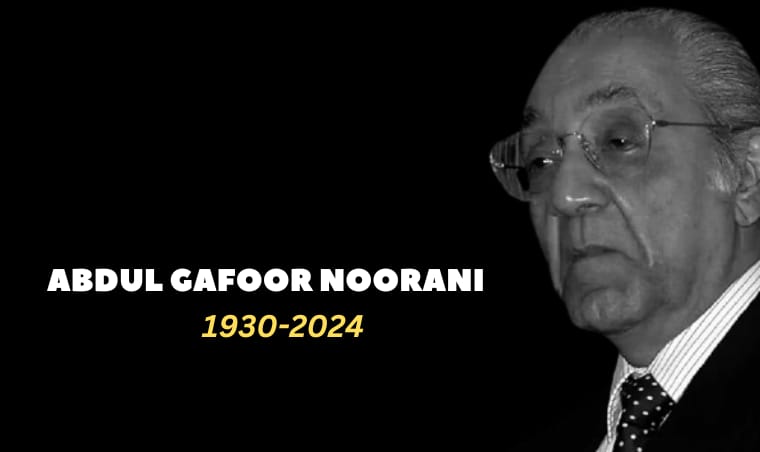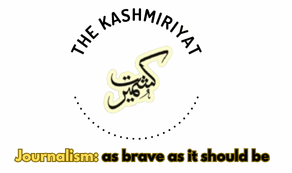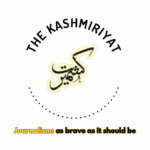
A. G. Noorani, a distinguished Indian lawyer, constitutional expert, and author noted for his voluminous publications on legal and political matters, notably those pertaining to Kashmir, died in Bombay, leaving a legacy to be remembered.
His work has influenced the academic and legal discourse on Kashmir, displaying a thorough awareness of the region’s history, politics, and complex connection with India.
Born September 16, 1930, in Bombay (now Mumbai), India, Abdul Gafoor Noorani was pursued a career at law, eventually becoming one of India’s most renowned constitutional attorneys. He has also written extensively for journals, newspapers, and books, frequently focused on civil freedoms, human rights, and the Kashmir conflict.
Noorani’s participation in Kashmir originates from his legal expertise and his desire to comprehend the region’s constitutional and historical issues. His publications on Kashmir provide a more detailed and critical study of the region’s political history.
Noorani’s most significant contributions stem from his investigation of Jammu Kashmir’s admission to India. Noorani’s work, “Article 370: A Constitutional History of Jammu Kashmir,” delves into the Indian Constitution’s Article 370, which grants Jammu Kashmir special status.
He claims that the Article 370 was not only a temporary measure, but was intended to protect the state’s autonomy, as agreed with during Kashmir’s accession to India in 1947.
In his book Article 370: A Constitutional History of Jammu and Kashmir, Noorani contends that Jammu and Kashmir’s accession was unique in contrast to other princely states. “The Instrument of Accession signed by Maharaja Hari Singh was conditional, subject to the approval of the people of Kashmir through a plebiscite, which was never conducted,” according to him.
Noorani’s work focuses on the legal and moral commitments that were overlooked while the Indian state increasingly degraded Kashmir’s autonomy.
His first direct link to Kashmir most likely occurred in the late 1950s, when he began practicing law and writing on legal and constitutional issues. The Kashmir Conspiracy Case of 1958, in which Noorani served as a member of Sheikh Abdullah’s defense team, was a watershed point in his career and relationship with Kashmir. Defending Sheikh Abdullah, a prominent player in Kashmir’s political scene, Noorani became strongly identified with the region’s legal fights and political instability.
Noorani has also written extensively about Kashmir’s political dynamics, with a special emphasis on the influence of central government policies on regional autonomy and the emergence of militancy. Noorani’s book, Kashmir Dispute 1947-2012, describes his initial participation in Kashmir during the Kashmir Conspiracy case against Sheikh Abdullah and his companions. However, he does not go into detail about his own position as a defense lawyer.
Noorani criticized the Indian government’s policy to Kashmir, notably its use of military force and suppression of opposition. He claims that these activities have further alienated the people of Kashmir and exacerbated the conflict. Noorani, A. G. The Kashmir Dispute, 1947-2012.
A.G. Noorani’s The Kashmir Dispute: 1947-2012 is a comprehensive study that combines his essays into a careful research piece providing a thorough examination of the Kashmir from political, diplomatic, legal, and, most importantly, human aspects.
The book’s lengthy 148-page introduction, with a total of 550 pages, may appear strange. However, this introduction is critical, giving uniqueness via meticulous investigation using rare materials from many sources.
It, together with the appendices, offers facts regarding the Kashmir conflict—a disagreement that sparked two wars between India and Pakistan before they became nuclear powers, and nearly led to a third war in 1999 when both countries possessed weapons of mass destruction.
Noorani traces the suffering of the Kashmiri people back to sixteenth century, when Mughal emperor sent troops to Kashmir, initiating 166 years of Mughal rule, followed by the harsh Afghan and Sikh dynasties.
The situation further evolved when Gulab Singh, the Dogra emperor, became the ruler of the Muslim-majority Kashmir by paying Rs 7.5 million to the British government on March 16, 1846. Noorani’s empathy for the Kashmiri people is evident as he critiques nearly all Pakistani and Indian leaders, and the British government, for their mishandling of the issue. He even holds Jinnah accountable for reasons unique to his perspective. Among the figures he criticizes, Noorani views Jawaharlal Nehru as the primary antagonist, accusing the first Prime Minister of India of misleading Parliament, conspiring against Sheikh Abdullah, dismissing Abdullah’s government, and arresting him on false charges.
In October 1947, Nehru assured the Prime Ministers of Pakistan and Britain that aid to Kashmir was not intended to influence its accession to India. He emphasized that the decision on accession should be made according to the people’s wishes—a stance he reiterated in subsequent telegrams. On November 8, 1947, Nehru reaffirmed that good relations between the two Dominions required acceptance of the principle that where a state’s ruler did not share the majority religion of his subjects, the question of accession should be determined by the will of the people, Noorani writes.
Noorani examines the 1988-89 armed militancy in Kashmir. Noorani argues that the sense of victimhood among Kashmiris, which no Indian government has adequately addressed, is central to understanding the conflict.
Noorani reflects on whether there was a serious attempt to resolve the Kashmir issue after Kargil. He highlights the four-point plan proposed by Musharraf, who managed to gain Manmohan Singh’s support for a plan offering “equal autonomy” to Kashmir on both sides.
The Kashmir Conspiracy Case was a watershed moment in Indian history, steeped in the intricate political dynamics of post-independence Kashmir. Sheikh Abdullah, the Prime Minister of Jammu Kashmir at the time, was ousted and detained by the Indian government in 1953 on the instructions of then-Prime Minister Jawaharlal Nehru. Abdullah was accused of collaborating with Pakistan to build an independent Kashmir distinct from India.
The lawsuit, formally titled State vs. Sheikh Mohammad Abdullah and Others, began in 1958. It stated that Abdullah and some of his colleagues were involved in a scheme to undermine the Indian state and secure Kashmir’s independence with the help of overseas forces.
Sheikh Abdullah’s legal defense team included Noorani, who was already a well-known lawyer and constitutional specialist at the time. Noorani, recognized for his extensive knowledge of constitutional law and civil liberties, was an obvious candidate to represent Abdullah in this “politically charged matter.”
His defense was based on the claim that the allegations against Abdullah were politically motivated and lacked solid proof. He said that Abdullah’s activities were motivated by a desire to protect the autonomy and well-being of the people of Jammu Kashmir, rather than a desire to conspire against the Indian state.
Noorani underlined the Indian government’s claims about Kashmir’s autonomy, as well as the political tactics that led to Abdullah’s incarceration.
The case went on for years, becoming a symbol of the greater political conflict over Kashmir’s destiny. The case was subsequently dismissed in 1964, owing to a lack of convincing evidence and a changing political context, including Nehru’s wish to reconcile with Sheikh Abdullah following the great political rebellion in Kashmir over the theft of sacred relics (Tehreek e Moi Muqadas). Victoria Schofield explores the political significance of the Moi-e-Muqaddas movement, which resulted in substantial changes in the Indian government’s policy to Kashmir. The disturbance produced by the movement is seen as a crucial reason in prompting the government to consider releasing Sheikh Abdullah, who was regarded as a leader capable of calming the situation.
The dropping of the case led to Sheikh Abdullah’s release from prison.
Noorani’s engagement in the case was part of a larger effort to safeguard civil freedoms and challenge what he perceived as state misrule. His defense of Sheikh Abdullah cemented his image as a courageous fighter for justice and an outspoken opponent of government actions that threaten constitutional safeguards. The case was only one of several cases in which Noorani spoke out against what he saw as unjust treatment of Kashmir’s political leaders.
His role in the case was more than simply defending one individual; it was part of a bigger effort to protect the constitutional rights of the people of Jammu Kashmir.
Throughout his career, Noorani has campaigned for a peaceful resolution of the Kashmir dispute via communication and diplomacy. He has always advocated for the restoration of autonomy in Jammu Kashmir as a first step toward settling the Kashmir imbroglio. According to Noorani, the Kashmir issue cannot be addressed militarily, but rather via a political settlement that respects the Kashmiri people’s aspirations.
His role in the case was more than simply defending one individual; it was part of a bigger effort to protect the constitutional rights of the people of Jammu Kashmir.
Throughout his career, Noorani has campaigned for a peaceful resolution of the Kashmir via communication and diplomacy. He has always advocated for the restoration of autonomy in Jammu Kashmir as a first step toward settling the issue.
His writings serve as a compelling reminder of the role of constitutionalism, diplomacy, and respect for regional autonomy in conflict resolution. Noorani’s work is a valuable resource for comprehending the Kashmir issue, inspiring researchers, attorneys, and politicians alike.




